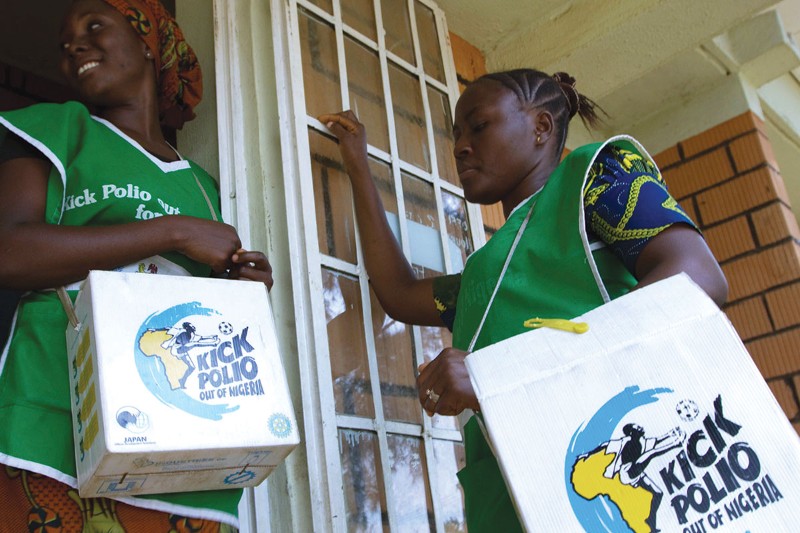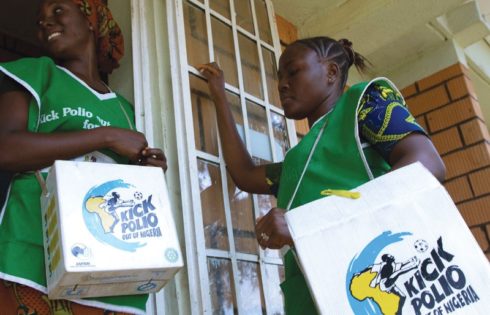
 Today, Nigeria is marking a major milestone in the polio eradication effort: two years without a single new case of wild polio. This success extends continent-wide, with Africa expected to mark the same milestone on August 11. If the African region succeeds in going another year without polio, it will be certified polio-free in 2017, taking us one step closer to a polio-free world.
Today, Nigeria is marking a major milestone in the polio eradication effort: two years without a single new case of wild polio. This success extends continent-wide, with Africa expected to mark the same milestone on August 11. If the African region succeeds in going another year without polio, it will be certified polio-free in 2017, taking us one step closer to a polio-free world.
This is incredible progress, but it hasn’t come easy. Over the past few years, thousands of volunteer health workers, government officials, traditional and religious leaders have dedicated their careers and lives to the eradication effort. New strategies have been implemented to deliver polio vaccines to nomadic populations, families living in remote, and sometimes insecure areas. Rigorous disease surveillance networks were set up improve monitoring for any new emergence of polio, and new microplans helped ensure no children were missed by vaccines.
Now, as the world’s attention has shifted to Pakistan and Afghanistan – the last two polio-endemic countries – Nigeria and the rest of Africa still face a difficult task ahead: staying polio-free. This means both sustaining the hard work that has already happened, and continuing to make improvements. It means strengthening political and financial commitment at all levels of government and filling any gaps in disease surveillance. It also means further improving vaccination coverage and campaign quality, particularly in hard-to-reach, insecure and underserved areas.
We must also remember that keeping Nigeria and Africa polio-free isn’t just about a single disease. The infrastructure created to end polio is making a dramatic impact on the overall health of communities.
I saw this first-hand when Ebola emerged in Lagos, Nigeria, in July 2014. I was living in Abuja at the time, working as the Deputy Incident Manager/Chief Operations Officer of Nigeria’s Polio Emergency Operations Center, a unique model for coordinating polio eradication activities. We saw that our work to end polio offered important lessons, infrastructure and resources for stopping the outbreak, so I packed my bags and headed to Lagos. There we worked to set up a similar operations center to coordinate the Ebola response, and fortunately it proved to be effective. The Ebola outbreak in Nigeria was declared over just three months after it started. If we didn’t have the resources and knowledge we had gained after years of battling polio, the outcome could have been very different, with devastating consequences as we witnessed in neighboring countries.
The polio experience and infrastructure may once again prove critical in responding to other health emergencies, but, just as importantly, it can be used for disease prevention. As a result of the polio program, frontline health workers are delivering other critical health interventions to children in hard-to-reach and insecure areas, including vitamin A supplements, measles vaccinations and treatment of common diseases such as malaria. Surveillance networks used to identify poliovirus in the environment and trace contacts during outbreaks are also helping countries better map and monitor the presence of other diseases and respond quickly to outbreaks.
Today, we’re closer than ever before to a polio-free future – but the work in Africa is not done. Keeping Nigeria and Africa polio-free requires us to remain focused on reaching every child with vaccines and improving the systems we have in place to monitor and stop outbreaks.
As with most of life’s journeys, it is that last mile, that last hurdle or how we turn that last corner that requires us to muster the best parts of our abilities. If we do it right, if we succeed, then we can ensure a world free of a polio and a healthier future for children everywhere.
Faisal Shuaib,
Senior Program Officer at the Bill & Melinda Gates Foundation
